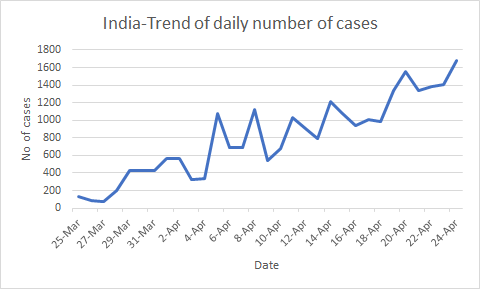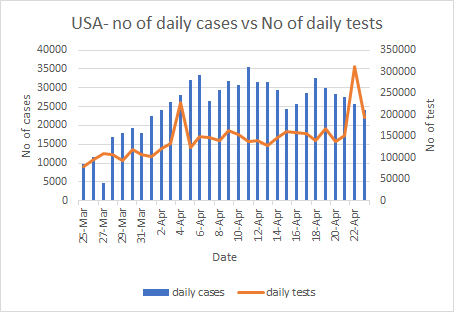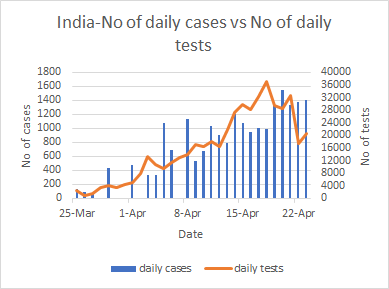These are the challenging times and day in and day out everyone is talking about the corona virus. India so far has dealt the pandemic quite effectively. Its been a month since the lockdown in India has started and therefore this is a right time to look at the data, patterns and trend of the spread of COVID-19 in this last one month.
S. Korea is praised a lot for its testing capacity which is quite high in terms of per million population. There is one other major factor to determine whether a country is carrying out optimal tests- the ratio of average daily tests performed to that of average daily number of confirmed cases. This ratio implies that number of tests performed on any given day must be more than number of cases on that day by the factor equal to this ratio. For the period between 25th March to 21st April this ratio is 135.5 for S.Korea. This essentially means for one confirmed case, S.Korea is testing around 135 samples. For the same period, this ratio for USA is 5.3 whereas for India it is 24.
 As can be seen from the graph showing the cumulative tests carried out for COVID-19 by S.Korea vis-a-vis by India. In case of India, the growth rate of number of tests specially from 10th of April is certainly assuring. Participation of the private players, rapid testing kits, exploring the option of pooled tests options specially in the hotspot areas, nudging more and more people to voluntarily come forward for getting tested are some of the options for increasing the testing capacity.
As can be seen from the graph showing the cumulative tests carried out for COVID-19 by S.Korea vis-a-vis by India. In case of India, the growth rate of number of tests specially from 10th of April is certainly assuring. Participation of the private players, rapid testing kits, exploring the option of pooled tests options specially in the hotspot areas, nudging more and more people to voluntarily come forward for getting tested are some of the options for increasing the testing capacity.
As in the earlier article, here also the data for number of confirmed cases is sourced from WHO's daily situation reports for uniformity and global view point. WHO data has some limitations because of reporting issues, methodology of reporting by different countries etc, but as of now no other source is available to get the global data.
Let us first start with the trend in the number of cases in this last one month in India. In the country of the size of India, many of the epidemiologists are predicting that numbers will be tremendously huge.
As can be seen from the graph, daily number of the cases are certainly increasing which is a cause of concern. If we consider the average, in this last one month, daily 808 confirmed cases were found. But micro level view suggest that the average for the first half of the month is just around 480 whereas for the second half it is around 1117. Therefore the average cases found per day are on rise. But the percentage growth of cases in India is lesser than many of the western countries.
Though the global picture in this regard is very bleak, India cannot afford to take relief from the fact that daily rise in number of cases is comparatively less. Timely lockdown and social distancing measures have certainly played key role in keeping the numbers within bound till now, but slightest of the error and violation of social distancing norms may cost a lot.
Now if we see the trend of percentage of growth of cases day on day basis, then it is continuously declining in India specially since 8th of April leaving aside some sporadic spikes. Data shows that from 20th April to 24th April the percentage growth of daily cases is hovering between 7% to 8%. If we consider the the pattern of daily percentage growth rate of confirmed cases in some of the worst hit countries of the world, and apply the same pattern to Indian scenario, factoring the strict lockdown measures in place, then by 3rd of May there will be around 45000 confirmed cases going as per the growth pattern. As per the similar statistical model and growth rate pattern, suppose the same lockdown provisions are extended beyond 3rd May till 18th May, then the number of cases by 18th May will be around 70000.
(Please note that these are predictions are completely based on the statistical patterns and trends across the countries. Any major event or mishap contrary to the social distancing norms etc may derail the pattern. Also with the time being, testing capacities are also ramped-up to various degrees which will also affect the number of cases accordingly. Also the policy decisions like extending the lockdown cannot be merely taken on the basis of statistical models. The situation may be assessed as it unfolds and suitable decision in this regard may be taken considering the lives and livelihoods of all.)
Now as far as testing capacities are concerned, it will be interesting to take a look at the pattern between number of cases vis-a-vis daily number of cases.
S. Korea is praised a lot for its testing capacity which is quite high in terms of per million population. There is one other major factor to determine whether a country is carrying out optimal tests- the ratio of average daily tests performed to that of average daily number of confirmed cases. This ratio implies that number of tests performed on any given day must be more than number of cases on that day by the factor equal to this ratio. For the period between 25th March to 21st April this ratio is 135.5 for S.Korea. This essentially means for one confirmed case, S.Korea is testing around 135 samples. For the same period, this ratio for USA is 5.3 whereas for India it is 24.
India is rapidly ramping-up the testing capacity and by 3rd May this ratio for India should be minimum 50 for entering the post-lockdown phase effectively, securely and sustainably. For reaching to this ratio, we will have to step up the testing capacity by 35 to 40% day on day which is currently growing at the rate of around 10% day on day between 25th March to 23rd April.
 As can be seen from the graph showing the cumulative tests carried out for COVID-19 by S.Korea vis-a-vis by India. In case of India, the growth rate of number of tests specially from 10th of April is certainly assuring. Participation of the private players, rapid testing kits, exploring the option of pooled tests options specially in the hotspot areas, nudging more and more people to voluntarily come forward for getting tested are some of the options for increasing the testing capacity.
As can be seen from the graph showing the cumulative tests carried out for COVID-19 by S.Korea vis-a-vis by India. In case of India, the growth rate of number of tests specially from 10th of April is certainly assuring. Participation of the private players, rapid testing kits, exploring the option of pooled tests options specially in the hotspot areas, nudging more and more people to voluntarily come forward for getting tested are some of the options for increasing the testing capacity.
The general observations of the last one month can be summed up as follows:
1. The last one month has shown us that in the time of crisis in India many many hands come forward for the help and assistance which is very assuring thing in such unpredictable times. All such efforts will be more effective if better coordination and synergy between work of civil society, NGOs, government, private sector can be achieved.
2. Another important area is de-stigmatization of COVID-19 which in long run will be very detrimental. Social, spiritual, religious leaders in local areas can play important role in this regard.
3. All the disasters require training to handle them effectively. But effective training is feasible only prior to the onset of disaster. The lack of training leads to panic, stigma, fear-mongering and chaos at the time of onset of disaster. Therefore training to NSS, NCC candidates, local volunteers, NGOs and very importantly the members of PRIs including gram-panchayat at village level, panchayat samiti at tehsil level and zila parishad at district levels. Recently Prime Minister has communicated with Sarpanchas of Gram Panchayat across the country.
4. COVID-19 in a way is the first pandemic after social media became so dominant. In this era we are not just fighting the pandemic but 'Infodemic' as well as WHO is also highlighting. We have experienced disastrous effects of misinformation, rumors in the incidences like mob killing in Palghar, huge crowd gathering in Bandra, Mumbai etc. Therefore this is high time to simultaneously fight this infodemic. Taking action against those spreading rumors, misinformation is necessary but not sufficient. News and information which reaches to the people first have the 'priming effect' and it sets the agenda even though later it is established as fake news. Therefore along with 'fact-check' which is essentially post-mortem work, government and all the right-intentioned people should spread the right, correct and useful information even before any fake news is spread.
Without a doubt these are testing times for all of us. But always remember, "Hope is a good thing and no good thing ever dies."




No comments:
Post a Comment